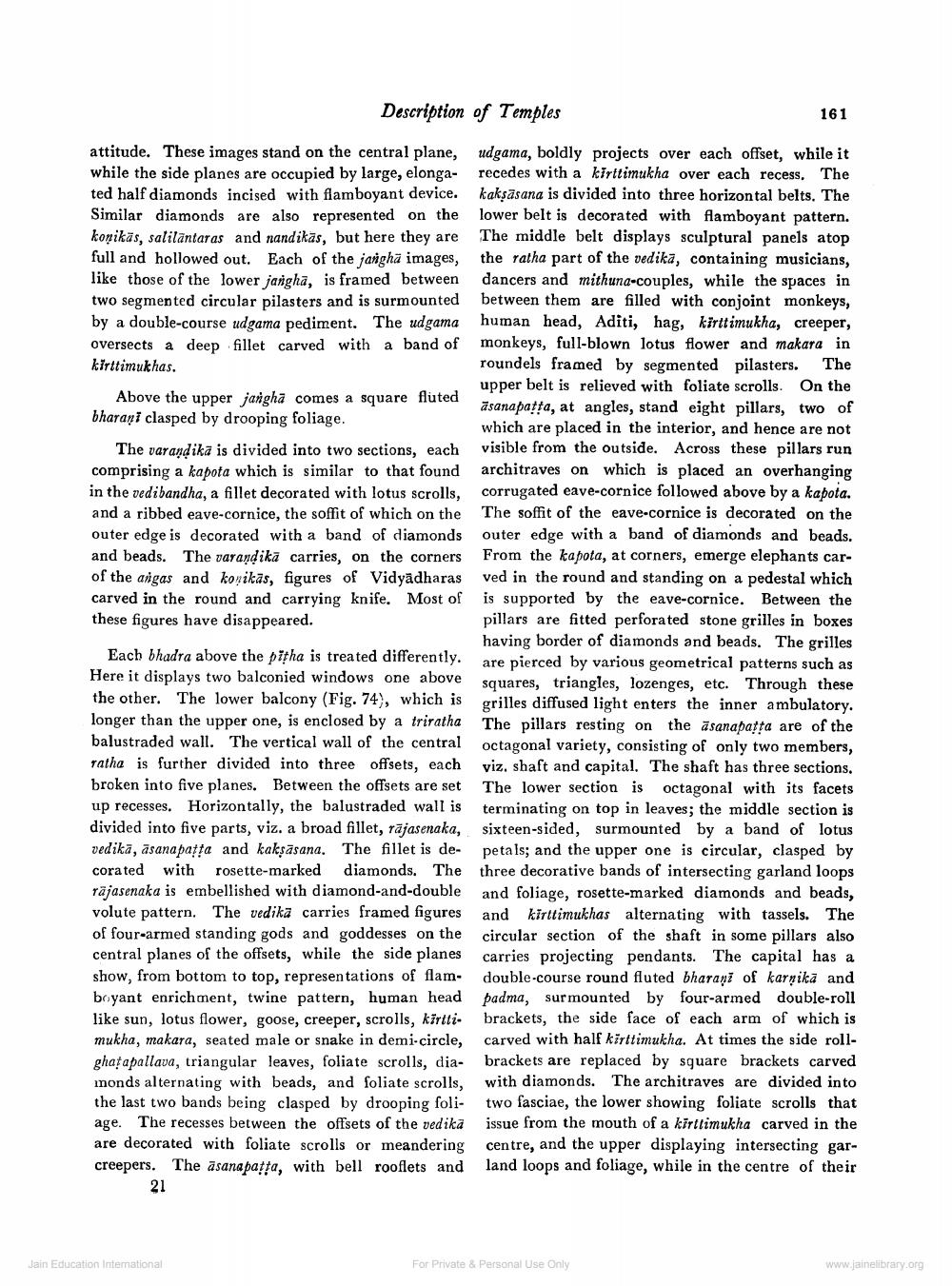________________
Description of Temples
161
attitude. These images stand on the central plane, udgama, boldly projects over each offset, while it while the side planes are occupied by large, elonga- recedes with a kirttimukha over each recess. The ted half diamonds incised with flamboyant device. kaksāsana is divided into three horizontal belts. The Similar diamonds are also represented on the lower belt is decorated with flamboyant pattern. konikās, salilantaras and nandikās, but here they are the middle belt displays sculptural panels atop full and hollowed out. Each of the janghā images, the ratha part of the vedikā, containing musicians, like those of the lower janghā, is framed between dancers and mithuna-couples, while the spaces in two segmented circular pilasters and is surmounted between them are filled with conjoint monkeys, by a double-course udgama pediment. The udgama human head, Aditi, hag, kirttimukha, creeper, oversects a deep fillet carved with a band of monkeys, full-blown lotus flower and makara in kirttimukhas.
roundels framed by segmented pilasters. The
upper belt is relieved with foliate scrolls. On the Above the upper jangha comes a square fluted
āsanapatta, at angles, stand eight pillars, two of bharani clasped by drooping foliage.
which are placed in the interior, and hence are not The varandika is divided into two sections, each visible from the outside. Across these pillars run comprising a kapota which is similar to that found architraves on which is placed an overhanging in the vedibandha, a fillet decorated with lotus scrolls, corrugated eave-cornice followed above by a kapota. and a ribbed eave-cornice, the soffit of which on the The soffit of the eave-cornice is decorated on the outer edge is decorated with a band of diamonds outer edge with a band of diamonds and beads. and beads. The varandika carries, on the corners From the kapota, at corners, emerge elephants carof the angas and konikas, figures of Vidyadharas ved in the round and standing on a pedestal which carved in the round and carrying knife. Most of is supported by the eave-cornice. Between the these figures have disappeared.
pillars are fitted perforated stone grilles in boxes
having border of diamonds and beads. The grilles Each bhadra above the pitha is treated differently.
are pierced by various geometrical patterns such as Here it displays two balconied windows one above squares, triangles, lozenges, etc. Through these the other. The lower balcony (Fig. 74), which is grilles diffused light enters the inner ambulatory. longer than the upper one, is enclosed by a triratha The pillars resting on the āsanapatta are of the balustraded wall. The vertical wall of the central octagonal variety, consisting of only two members, ratha is further divided into three offsets, each viz. shaft and capital. The shaft has three sections, broken into five planes. Between the offsets are set The lower section is octagonal with its facets up recesses. Horizontally, the balustraded wall is terminating on top in leaves; the middle section is divided into five parts, viz. a broad fillet, rājasenaka, sixteen-sided, surmounted by a band of lotus vedika, asana pasta and kaksāsana. The fillet is de- petals; and the upper one is circular, clasped by corated with rosette-marked diamonds. The three decorative bands of intersecting garland loops raiasenaka is embellished with diamond-and-double and foliage, rosette-marked diamonds and beads, volute pattern. The vedika carries framed figures and kirttimukhas alternating with tassels. The of four-armed standing gods and goddesses on the circular section of the shaft in some pillars also central planes of the offsets, while the side planes carries projecting pendants. The capital has a show, from bottom to top, representations of flam- double-course round fluted bharani of karnika and boyant enrichment, twine pattern, human head padma, sur mounted by four-armed double-roll like sun, lotus flower, goose, creeper, scrolls, körtti- brackets, the side face of each arm of which is mukha, makara, seated male or snake in demi-circle, carved with half kirttimukha. At times the side rollghatapallava, triangular leaves, foliate scrolls, dia- brackets are replaced by square brackets carved monds alternating with beads, and foliate scrolls, with diamonds. The architraves are divided into the last two bands being clasped by drooping foli- two fasciae, the lower showing foliate scrolls that age. The recesses between the offsets of the vedika issue from the mouth of a kiritimukha carved in the are decorated with foliate scrolls or meandering centre, and the upper displaying intersecting garcreepers. The asanapatta, with bell rooflets and land loops and foliage, while in the centre of their
Jain Education International
For Private & Personal use only
www.jainelibrary.org




